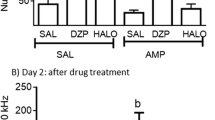Abstract
Phencyclidine (PCP) given to male Wistar rats produced hyperactivity and various stereotypic motor behaviors. Methadone, apomorphine, and naloxone were tested for their effects on PCP-induced stereotypy. Methadone (0.5 mg/kg) had not effect on the hyperactivity produced by PCP, but significantly attenuated PCP-induced stereotypy when given both before and after PCP. Low doses of apomorphine were equally effective as methadone in attenuating PCP-induced stereotypy. However, when naloxone was given after methadone or apomorphine to PCP-treated rats, the full PCP-induced stereotypy was again observed. Naloxone pretreatment in doses up to 20 mg/kg was not effective in antagonizing PCP-induced behavioral effects. Methadone and apomorphine antagonism of PCP-induced stereotypy may be mediated by opiate receptors. The results of this study and observations from human studies collectively suggest the possible effectiveness of opiates in treating PCP-induced and functional psychoses.
Similar content being viewed by others
References
Amden NE, Rubenson A, Fuxe K, Hokfelt T (1967) Evidence for dopamine receptor stimulation by apomorphine. J Pharm Pharmacol 19:627–629
Balster RL, Chait LD (1976) The behavioral pharmacology of phencyclidine. Clin Toxicol 9:513–528
Balster RL, Chait LD (1978) The behavioral effects of phencyclidine in animals. In: Peterson RC, Stillman RC (eds) PCP, phencyclidine abuse: An appraisal. NIDA Research Monograph 21, p 53
Grown JK, Malone MH (1973) Some U.S. street drug identification programs. J Am Pharm Assoc 13:670–676
Domino EF (1978) Neurobiology of phencyclidine: An update. In: Petersen RC, Stillman RC (eds) PCP, Phencyclidine abuse: An appraisal. NIDA Research Monograph 21, p 18
Garey RE (1979) PCP (phencylidine): An update. J Psychedelic Drugs 11:265–275
Garey RE, McQuitty S, Toole D, Heath RG (1980) The effect of apomorphine and haldol on PCP-induced behavioral and motor abnormalities in the rat. Life Sci 26:277–284
Greifenstein FE, Devault M, Yoshitake J, Gajewski JE (1958) A study of l-arylcyclohexylamine for anaesthesia. Anesthes Analg Cleve 37: 283–294
Hart JB, McChesney JC, Grief M (1972) Composition of illicit drugs and use of drug analysis and abuse abatement. J Psychedelic Drugs 5:83–88
Johnstone M, Evans V, Bugel S (1959) Sernyl (CI-395) in clinical anesthesia. Br J Anaesthesia 31:433–439
Luby ED, Cohen BD, Rosenbaum G, Gottlieb JS, Kelly R (1959) Study of a new schizophrenomimetic drug: Sernyl. Arch Neurol Psychiatry 81:363–369
Luisada PV, Brown BI (1976) Clinical management of the phencyclidine psychosis. Clin Toxicol 9:539–549
Pryor GT, Howd RA (1979) Effects of chronic treatment with morphine, methadone and LAAM on the response to phencyclidine in rats. In: Harris LS (ed) Proceedings of problems on drug dependence. NIDA Research Monograph 27, p 212
Quock RM, Welsh TB, Burda M, Lucas TS (1980) The influence of naloxone pretreatment upon apomorphine and l-dopa-induced drug effect in several experimental paradigms. Pharmacologist 22:186
Rodgers J, Deacon RMJ (1979) Effect of naloxone on behavior of rats exposed to a novel environment. Psychopharmacology 65:103–105
Sasame HA, Perez-Cruet J (1972) Evidence that methadone blocks dopamine receptors in the brain. J Neurochem 19:1953–1957
Sturgeon DR, Fessler RG, Meltzer HY (1979) Behavior rating scale for assessing phencyclidine-induced locomotor activity, stereotyped behavior and ataxia in rats. Eur J Pharmacol 59:169–179
Verebey K, Volavka J, Clouet DH (1978) Endorphins in psychiatry: An overview and a hypothesis. Arch Gen Psychiatry 35:877–888
Young CA (1980) Naloxone enhancement of punishment in the rat. Life Sci 26:1787–1792
Author information
Authors and Affiliations
Rights and permissions
About this article
Cite this article
Verebey, K., Kogan, M.J. & Mule, S.J. Phencyclidine-induced stereotypy in rats: Effects of methadone, apomorphine, and naloxone. Psychopharmacology 75, 44–47 (1981). https://doi.org/10.1007/BF00433500
Received:
Accepted:
Issue Date:
DOI: https://doi.org/10.1007/BF00433500




